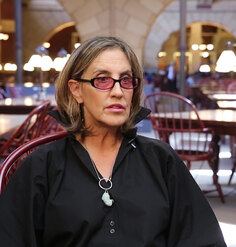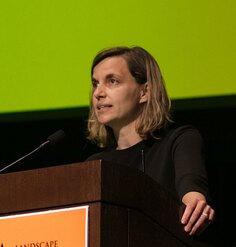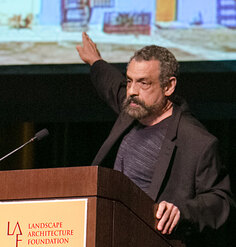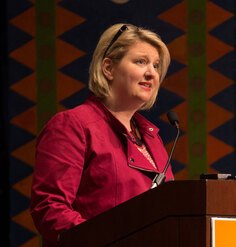Cities for People and Cities for the Planet
By Blaine Merker
This presentation was part of the Landscape Architecture Foundation’s The New Landscape Declaration: A Summit on Landscape Architecture and the Future held in Philadelphia on June 10-11, 2016. LAF asked a diverse group of leading minds to write a “Declaration” reflecting on the last half century and offering bold ideas for how landscape architecture can make its vital contribution in response to the challenges of our time.
Blaine Merker
Director, Gehl Studio
San Francisco, California
Blaine Merker heads the San Francisco office of Gehl, an international design consultancy based in Copenhagen. Merker earned his master of landscape architecture from the University of California, Berkeley, where he also teaches, and holds a bachelor’s degree in history from Reed College.
*Affiliation at the time of the Summit
Cities for People and Cities for the Planet
By Blaine Merker
In 1966, Americans were abandoning central cities and leaving a trail of pollution and landscape destruction as we built into the countryside. But 50 years on, a new era has begun and we have turned back to many of those same cities. How we design them now holds the key to two of the most important questions humans face: how to live sustainably on our planet and how to be happier doing so.
Cities have unlocked a secret in the last decade: the actions that are most sustainable and even healthy are the most enjoyable as well. They let us use our bodies, they give us greater freedom, they connect us to other people, and they fill our time with things we would rather be doing anyway. Cities give us access without the burden of ownership—access to mobility, to great amenities, to experiences. They are the ultimate innovation in resource efficiency.
Cities are experiments, and lately the distance between citizen and plan has shortened as guerrilla bureaucrats use tactical interventions that make change quicker and more nimbly. At a time when national politics are polarized and international agreements take decades, the creativity and economic might of cities have given them the resolve and the clout—more than any other part of society—to take bold environmental action. Landscape architects play leading roles in this urban story, providing innovation and inspiration by fusing human and natural processes.
But cities offer something else as well: a celebration of the human condition. Good urbanism is humanism made physical. It is a celebration of the prosaic things that make us happy. Cities let us move freely using our own bodies, they engage our senses, and they bring us together physically and in spirit. It is no wonder that cities are where talent and opportunity collect, but some are in such demand they have become exclusive enclaves. In fact, human-scale urbanism—the thing that makes cities livable—has become so coveted and is in such short supply that Silicon Valley runs its own commuter lines back to San Francisco because so many of its workers prefer to live in the city. We know from economists that income-diverse neighborhoods with short commute times create greater intergenerational economic mobility. But that opportunity is being eroded because we now have a supply problem: not enough good and green urbanism to go around. Those who cannot afford it are pushed to a kind of resource-intensive landscape that not only threatens our planet but also does not provide most of what people are increasingly looking for.
The energy-intensive, dispersed, and functionally separated “modernist” city is the great ecological experiment of the last half century. It requires people to travel long distances for daily routines. Pleasant isolated environments have been created in this experiment, to be sure, but access to collective goods and social connection here is a fragile privilege, propped up by highly subsidized individual mobility.
Along with the rise of the modernist urban form, America has become increasingly divided into two visions of how to live on the land and with one another: one dispersed and resource intensive, the other increasingly connected and efficient. This divide is mirrored in our culture and in our politics to such an extent that it sometimes seems like Americans just miles apart see the world very differently.
Landscape architecture’s historical role in the modernist experiment has been to hide, bandage, decorate, and soften the profound impact of dispersal, resource-intensive transportation, and fundamental lack of human scale. It is an uncomfortable truth that our profession has often been beholden to antihumanist economics. While we protect health and safety, the risks that landscape architects mitigate are often the direct result of an inhumane urbanism operating at a scale just out of our reach.
Our experiment has exacted a sacrifice: the disproportionate use of resources, energy, and time. Compare the footprints of Atlanta and Barcelona, two cities of roughly five million people. Atlanta uses 25 times more land and produces more than 10 times the carbon dioxide (CO2) than Barcelona.
The transportation sector is not the only issue. Additional design problems arise when we must then manage stormwater from acres of pavement or try to make mechanized landscapes safe for kids to walk to school. These are, frankly, problems we chose and which now consume much more of our design attention than they should.
The final accounting of our landscape choices is being done in our climate system, though the urgency of this, too, depends on which Americans you talk to. Where climate change is seen as a threat corresponds to the fault lines in our politics, culture, and our built environment. The kind of place we live, its political culture, and its built form, determine what we believe about our global climate system. The people who have the most at stake in dispersed, energy-intensive landscapes are the least likely to believe a problem exists.
We do not know exactly how Americans will be affected by climate change. We do know that the dispersal, separation, and mechanization of our landscape cause an experiment in CO2 not seen in over a million years. Is it affecting us yet? The year 2016 was the warmest year on record globally. Warming is not happening everywhere equally. One place that is cooler is the southern tip of Greenland where its glaciers are turning to liquid and flowing into the Atlantic.
Our charge is not just the safety of individual people but the safety of humankind. Our envelope of best practices simply is not wide enough to address the real scale of the challenge—we need a new mentality that radically refocuses our vision.
Our changing climate is a warning that the experiment we have been running not only threatens the stability of our global ecosystem but is actually leading us further from happiness. The United States has the third highest commute times on the planet, behind only Bulgaria and Hungary. And while the option to commute is tied to economic opportunity, commutes beyond 20 minutes correlate with increasing personal misery.
And it is easy to see why. Mobility takes time and our time is limited. When we separate destinations too much, we displace nourishing mobility—the kind that makes us feel excited and free—with a “junk mobility” that makes us feel bored, trapped, and stressed out. We have less time for things that make us happy: exercise, relationships, and building community.
Junk mobility is also making us broke, requiring more investment than it pays back. Expensive highways subsidize far-flung trips for low-value economic activity. They sap central cities of the residents who could support a more efficient, compact transportation system. This is not a call to divest from infrastructure but rather to consider carefully the long-range future our infrastructures lock us into. The more energy our landscapes require, the less freedom we have to solve problems other than managing energy.
Four design principles for the urban landscape will move us toward a future that makes us happier, safer, richer, and will at least give us a shot at minimizing catastrophic changes to our climate system.
- First, celebrate the human dimension. A city built for people provides texture, delight, and usability for all ages and abilities. It is messy and its dimensions are smaller than most of what we build now. Human bodies, in all their idiosyncrasies and limitations, should be the client for every project.
- Second, connect people better and concentrate human activity into places that create vitality and convenience. Connecting with one or two modes of transport is not enough—multiple systems using minimal energy are required for real choice and freedom.
- Third, give future generations alternatives. If we do not build the cities our children and grandchildren need, they will have to use their own resources to rebuild what they inherit. Do not lock them into costly redesigns. Before sinking millions into parking garages that cannot be retrofitted or into new schools miles from neighborhoods, give the future generation—whose values will likely be different from our own—room to maneuver.
- Finally, build common ground by creating places that draw diverse populations together. We found that more than half of the users of New York’s street plaza program said they had gotten to know more people because of these spaces. People making under $50,000 were even more likely to say that. This is a model for how we can use place to create opportunity and connection and to bridge divides in our culture.
The good news is that the things that make us happiest—like deep relationships, human-scale environments, and a sense of kinship with those with whom we share place—are practically carbon neutral. Deep sustainability and happiness reinforce each other at every planning and design scale.
There is much work to do across all sectors of society, and landscape is but one part. But without place as an organizer and without cities leading the way, other solutions—such as alternative power sources and better resource management—will fall short. Landscape architects’ expertise, and more importantly their values, are essential. There is much work to do, and the moment to do it is now.











